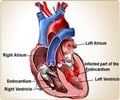A small but powerful new player that plays a role in the development and onset of heart failure has now been developed by a team of scientists

Using a functional screening system developed by researchers at Sanford-Burnham, the research team discovered miR-25 acts pathologically in patients suffering from heart failure, delaying proper calcium uptake in heart-muscle cells.
"Before the availability of high-throughput functional screening, our chance of teasing apart complex biological processes involved in disease progression like heart failure was like finding a needle in a haystack," said study co-senior author Mark Mercola, Ph.D., professor in the Development, Aging, and Regeneration Program at Sanford-Burnham and professor of bioengineering at UC San Diego Jacobs School of Engineering. "The results of this study validate our approach to identifying microRNAs as potential therapeutic targets with significant clinical value."
Mercola's laboratory has pioneered the use of robotic high-throughput methods of drug discovery to identify new targets for heart failure. According to co-lead study authors Christine Wahlquist and Agustin Rojas Muñoz, Ph.D., developers of the approach and researchers in Mercola's lab at Sanford-Burnham, they used high-throughput robotics to sift through the entire genome for microRNAs involved in heart-muscle dysfunction.
Subsequently, the researchers at the Cardiovascular Research Center at Icahn School of Medicine at Mount Sinai found that injecting a small piece of RNA to inhibit the effects of miR-25 dramatically halted heart-failure progression in mice. In addition, it also improved their cardiac function and survival.
"In this study, we have not only identified one of the key cellular processes leading to heart failure, but have also demonstrated the therapeutic potential of blocking this process," said co-lead study author Dongtak Jeong, Ph.D., a post-doctoral fellow at the Cardiovascular Research Center at Icahn School of Medicine at Mount Sinai in the laboratory of the study's co-senior author Roger J. Hajjar, M.D.
Advertisement
"Currently, heart-failure medications do not effectively address the underlying mechanisms that weaken contractile function and lead to the enlargement of heart-muscle cells," said co-senior study author Roger J. Hajjar, M.D. "Our study provides us with the key evidence we need to begin developing miR-25 as an important new therapeutic target, while adding our successful technique to block this microRNA to our growing arsenal of promising heart-failure therapies that we will further develop and test in future clinical trials."
Advertisement
Source-Eurekalert














